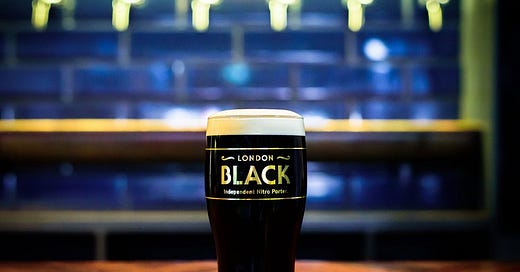GUINNESS IS GOOD for you. That is one of the great advertising slogans of all time. It worked, too.
Let’s face it, Guinness is more than a drink. It’s a lifestyle choice, a philosophy, an identity, a cultural symbol… This is the only beer I know that inspires loyalty like it’s a football team. Guinness supporters won’t have a bad word spoken about it.
But there are times when you don’t want all that baggage. You just want the best pint you can get.
And there are more interesting stouts and porters out there.
So when I posted on social media about Anspach & Hobday’s London Black (4.4%), suggesting it was better than Guinness, there was a storm of replies which confirmed the iconic status of Ireland’s most famous product.
Now, I’ve drunk a lot of Guinness over the years. In the early 1980s, when it was almost impossible to get a drinkable bitter or pale ale in Liverpool, I switched to the black stuff. It wasn’t until a decade later, when I discovered the craft beer revolution while living in California, that I moved away from Guinness.
Since then, I’ll order it in pubs that only stock macroswill beers. It’s generally reliable – as long as it’s well kept – if a little one-dimensional.
I crave a stout/porter every couple of weeks (just for clarity, porters tend to use malted barley, stouts roasted unmalted barley; Guinness use both). Notwithstanding that, A&H brewed London Black as an alternative to Guinness.
The pint of London Black I had at the weekend in a craft bar in south London was a bit too cold and was poured sloppily by the barperson – that’s why I’ve used a photo from the brewery’s website. How was it? Very good once it warmed a little.
The mouthfeel is very reassuring. Stouts and porters tend to take me back to a different age. In an alehouse by the Dublin docks just after dawn in the early 1980s, a local called a freshly poured pint of Guinness, “me mother’s milk” and proceeded to down it in one. I get that.
The London Black produces a wide range of flavours. It’s quite zesty (I hate tasting notes because everyone responds to flavours differently) and has a satisfying bitterness. The smokiness is not oppressive and doesn’t make a statement until after the swallow. I could easily have had a second one.
Instead, I went down the road to a more traditional pub and had a Guinness. Yes, I was right. This was a much less subtle pint. It was darker and smokier up front and didn’t make the tastebuds sing in the same way as the London Black.
But – and this surprised me – it was pretty damn good. I enjoyed it. No, it was not as multi-dimensional as London Black or the likes of Titanic’s Plum Porter, but it went down really well.
Both Guinness and London Black are nitro beers – nitrogen, rather than carbon dioxide is used in the carbonation process and the beer is pushed through tiny holes as it comes out of the tap. This creates the creamy head. For the last pint of the night, I sampled a Froth Blowers Riverside Stout (4.8%) on cask.
The warmer temperature suited the style of ale and having raved about Birmingham brewery last week, I’ll endorse it again. I prefer the carbonation in cask beers. This was very dry on the palate, quite tangy and with an abundance of late smokiness.
In the end, Guinness is still good for you, even if there are better alternatives. But try the London Black if you can – or another of the porters and stouts produced by smaller breweries. There is a world beyond Guinness.
Find London Black here with the brewery’s interactive map



